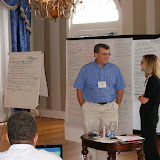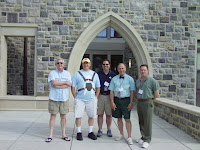Can You Come to Richmond Next Week?
Advocacy Alert - Call to Action! February 26, 2010
As Feared -
Virginia Foundation for the Humanities and the
Virginia Commission for the Arts are both eliminated from the House Budget.
Both the House and the Senate passed their versions of the State Budget for the next biennium.
The House of Delegates voted to reduce, and then eliminate all-together, the Virginia Foundation for the Humanities and the Virginia Commission for the Arts.
These two agencies provide the only state support for museums and the performing arts.
There is still a chance to change this course. The two versions (House and Senate) must be reconciled by the Conference Committee and submitted to a final vote by the two houses. It is vital that we make our case to the members of this committee.
Thank you so much to all of you who responded to our call to action yesterday. Although the House did not back down, believe me that your calls and emails were heard. But now we need to strengthen our approach.
Below is a list of the probable members of the Conference Committee. If you or your museum or site are located within the districts identified, we especially need you to act! If possible, we are organizing visits for next Wednesday, Thursday or Friday (March 3,4,5) to the conferees in the General Assembly building in Richmond. If you can join us, please call Margo at 804-788-5821, or email
mcarlock@vamuseums.org.
If you cannot join us, or cannot pay a personal visit another day, please phone or email your legislators. And it would be helpful if the rest of you would also phone or email your Delegate even if not a conferee - ask him or her to please encourage the conferees to save these two agencies.
YOU CAN MAKE A DIFFERENCE!
PROBABLE CONFEREES FOR BUDGET BILL
House of Delegates
Lacey Putney, Bedford, 19th district:
All of the City of Bedford; part of Bedford County comprised of the Stewartsville, Hardy, Otter Hill, Cove, Big Island, Sedalia, Kelso, Boonsboro, Montvale, Shady Grove, Thaxton, Goode, Liberty High School, and Sign Rock Precincts and parts of the Forest and Jefferson Precincts; and part of Botetourt County comprised of the Amsterdam, Asbury, Town Hall, Blue Ridge, Rainbow Forest, Mill Creek, Roaring Run, Buchanan 301/Springwood 304, Courthouse, Eagle Rock, Glen Wilton, Oriskany, and Troutville Precincts
Kirk Cox, Colonial Heights, 55th district
Part of Hanover County comprised of the Ashland, South Ashland, Ashcake, Beaverdam, Blunts, Wilmington Parish, Goddin's Hill, Clay, Chickahominy, Shady Grove, Atlee, Cool Spring, Courthouse, Rural Point 502/Newman 503, Village, Mechanicsville, Farrington, Montpelier, Rockville, and Elmont Precincts
Steve Landes, Weyers Cave, 25th district
All of the City of Waynesboro; part of Albemarle County comprised of the Crozet Precinct; part of Augusta County comprised of the Verona, Crimora, New Hope, Weyers Cave, Fort Defiance, Lyndhurst, Dooms, Fishersville, and Wilson Precincts; and part of Rockingham County comprised of the Mill Creek, Grottoes, Elkton, McGaheysville, and South Fork Precincts.
Chris Jones, Suffolk, 76th district
Part of the City of Chesapeake comprised of the Camelot, Crestwood, Oscar Smith School, Geneva Park, Georgetown, E. W. Chittum School, St. Julians, Sunray I, South Norfolk Fire Station, Carver School, Providence Church of Christ, Westover, Sunray II, and South Norfolk Recreation Precincts and part of Deep Creek Precinct; and part of the City of Suffolk comprised of the White Marsh, John F. Kennedy, Airport, and Hollywood Precincts and part of Cypress Chapel Precinct.
Johnny Joannou, Portsmouth, 79th district
Part of the City of Chesapeake comprised of the Taylor Road Fire Station Precinct; part of the City of Norfolk comprised of the Larchmont Library and Larchmont Recreation Center Precincts and parts of the Canterbury, Titustown Center, and Zion Grace Precincts; part of the City of Portsmouth comprised of the Ten, Eleven, Twenty-Two, Twenty-Three, Twenty-Four, Twenty-Five, Thirty, Thirty-Three, Thirty-Four, Thirty-Five, Thirty-Six, and Thirty-Seven/Thirty-Eight Precincts; and part of the City of Suffolk comprised of the Yeates Precinct and parts of the Harbor View and Nansemond River Precincts.
or possibly Roslyn Dance, Petersburg, 63rd district
All of Dinwiddie County; all of the City of Petersburg; and part of Chesterfield County comprised of the Ettrick and Matoaca Precincts and part of the Branches Precinct
Senate
Chuck Colgan, Manassas, 29th district
All of the Cities of Manassas and Manassas Park; part of Prince William County comprised of the Brentsville, Armory, Nokesville, Parkside, Jackson, Linton Hall, Woodbine, Park, Saunders, Enterprise, Coles, King, Dumfries, Graham Park, Pattie, Washington-Reid, Montclair, Evergreen, Haymarket, Loch Lomond, Sinclair, Stonewall, Sudley, Westgate, Catharpin, Bull Run, Plantation, Mullen, and Kerrydale Precincts and part of the Quantico Precinct.
Ed Houck, Spotsylvania, 17th district
All of Culpeper, Louisa, Madison, and Orange Counties; part of Spotsylvania County comprised of the Grange Hall, Maury, Plank Road, Frazers Gate, Belmont, Brokenburg, Todd's Tavern, Holbert, Salem, and Brent's Mill Precincts; and part of the City of Fredericksburg comprised of the District 1, District 3, and District 4 Precincts and part of the District 2 Precinct.
Richard Saslaw, Springfield, 35th district
Part of Fairfax County comprised of the Bristow, Chapel, Heritage, Kings Park, North Springfield #1, North Springfield #2, North Springfield #3, Ravensworth, Wakefield, Belvedere, Lincolnia, Masonville, Parklawn, Sleepy Hollow, Saint Albans, Westlawn, Weyanoke, Columbia, Brook Hill, Poe, Whittier, Walnut Hill #1, Bren Mar, Edsall, Graham, Greenway, Pine Spring, Shreve, Timber Lane, Woodburn, Merrifield, and Walnut Hill #2 Precincts; and part of the City of Alexandria comprised of the Hermitage, Southern Towers-Stratford, James K. Polk School, Patrick Henry School, Landmark Center, Charles E. Beatley Jr. Library, John Adams School, William Ramsay School, and South Port Precincts.
Janet Howell, Reston, 32th district
Part of Fairfax County comprised of the Reston #1, Reston #2, Dogwood, Hunters Woods, Reston #3, Glade, South Lakes, Terraset, North Point, Aldrin, Chain Bridge, Chesterbrook, Churchill, Cooper, El Nido, Great Falls, Haycock, Kenmore, Kirby, Langley, Longfellow, Mclean, Pimmit, Salona, Westhampton, Westmoreland, Herndon #1, Herndon #2, Clearview, Forestville, Herndon #3, Hutchison, Stuart, Sugarland, Hickory, Seneca, Marshall, Magarity, and Tysons Precincts.
William Wampler, Bristol, 40th district
All of Lee, Scott, and Washington Counties; all of the Cities of Bristol and Norton; part of Grayson County comprised of the Bridle Creek, Flatridge, Grant, Mouth Of Wilson, Mount Rogers, Rugby, Troutdale, Comers Rock, and Elk Creek Precincts; part of Smyth County comprised of the Seven Mile Ford, Chilhowie, St. Clair, East Park, West Park, Atkins, Wassona, Royal Oak East, Royal Oak West, Adwolfe, Sugar Grove, and Konnarock Precincts; and part of Wise County comprised of the North Coeburn, Wise, Big Stone Gap, East Stone Gap, Clinch Valley, and South Coeburn Precincts.
Tommy Norment, Williamsburg, 3rd district
All of Gloucester, James City, and New Kent Counties; all of the City of Williamsburg; part of York County comprised of the Queens Lake, Yorktown, Waller Mill, Nelson, Magruder, Seaford, Harris Grove, Edgehill, Dare, and Harwoods Mill Precincts; and part of the City of Newport News comprised of the Mcintosh, Reservoir, Lee Hall, and Nelson Precincts.
Walter Stosch, Glen Allen, 12th district
Part of Goochland County comprised of the Centerville and Manakin Precincts; part of Henrico County comprised of the Dumbarton, Glen Allen, Glenside, Greendale, Hermitage, Hilliard, Hunton, Johnson, Lakeside, Longan, Maude Trevvett, Moody, Staples Mill, Stratford Hall, Summit Court, Bloomingdale, Canterbury, Randolph, Chipplegate, Cardinal, Coalpit, Crestview, Freeman, Innsbrook, Jackson Davis, Lauderdale, Ridge, Sadler, Cedarfield, Skipwith, Three Chopt, Tucker, Westwood, Causeway, Stoney Run, Byrd, Lakewood, Derbyshire, Gayton, Godwin, Maybeury, Mooreland, Pemberton, Pinchbeck, Ridgefield, Rollingwood, Spottswood, Tuckahoe, and West End Precincts; and part of the City of Richmond comprised of the 309 Precinct.








 The faculty have been great - all the sessions have been outstanding, and they have provided a wealth of information and tips, referral to other resources, and generally the benefit of their years of experience in the museum world. They have made themselves available during breaks and mealtimes to answer questions, suggest options for specific situations our participants bring up, and have gone out of their way to be helpful.
The faculty have been great - all the sessions have been outstanding, and they have provided a wealth of information and tips, referral to other resources, and generally the benefit of their years of experience in the museum world. They have made themselves available during breaks and mealtimes to answer questions, suggest options for specific situations our participants bring up, and have gone out of their way to be helpful. 


 We also got to see the preserved Odd Fellows Hall, a museum celebrating the history of the African American inhabitants of Blacksburg,
We also got to see the preserved Odd Fellows Hall, a museum celebrating the history of the African American inhabitants of Blacksburg, 




 But there was plenty of silliness, too. We discovered there was no microwave but A.T. and I rummaged around the kitchenette and found a beat-up skillet and a cake pan - and "cowboy popcorn" was born. Rip open a package of microwave popcorn, put it in a skillet with the cake pan as "lid", and voila! A little smoky but definitely popped corn.
But there was plenty of silliness, too. We discovered there was no microwave but A.T. and I rummaged around the kitchenette and found a beat-up skillet and a cake pan - and "cowboy popcorn" was born. Rip open a package of microwave popcorn, put it in a skillet with the cake pan as "lid", and voila! A little smoky but definitely popped corn.